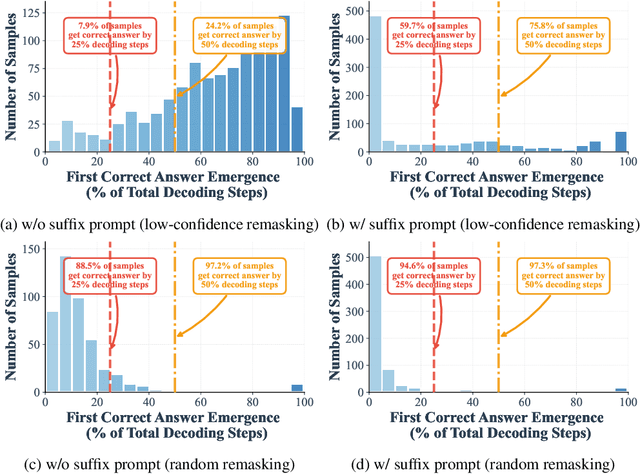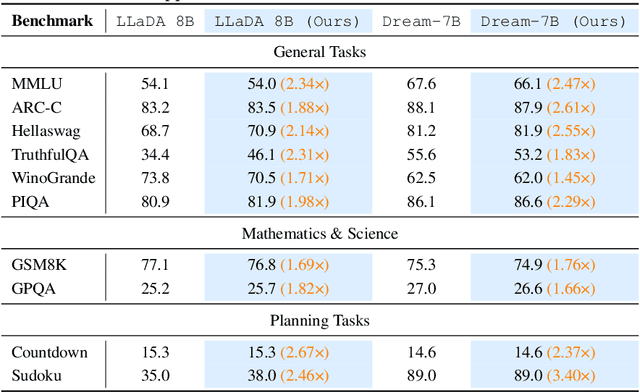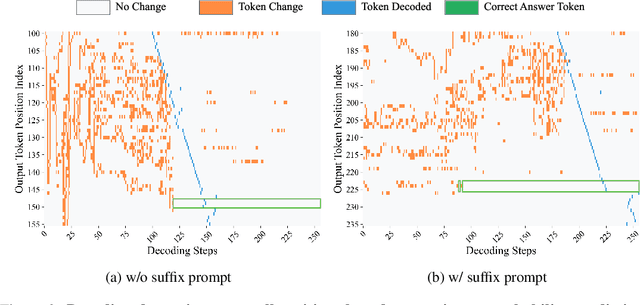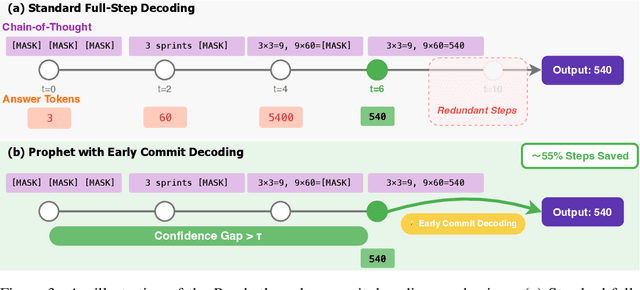Shilin Yan
Diffusion Language Models Know the Answer Before Decoding
Aug 27, 2025



Abstract:Diffusion language models (DLMs) have recently emerged as an alternative to autoregressive approaches, offering parallel sequence generation and flexible token orders. However, their inference remains slower than that of autoregressive models, primarily due to the cost of bidirectional attention and the large number of refinement steps required for high quality outputs. In this work, we highlight and leverage an overlooked property of DLMs early answer convergence: in many cases, the correct answer can be internally identified by half steps before the final decoding step, both under semi-autoregressive and random remasking schedules. For example, on GSM8K and MMLU, up to 97% and 99% of instances, respectively, can be decoded correctly using only half of the refinement steps. Building on this observation, we introduce Prophet, a training-free fast decoding paradigm that enables early commit decoding. Specifically, Prophet dynamically decides whether to continue refinement or to go "all-in" (i.e., decode all remaining tokens in one step), using the confidence gap between the top-2 prediction candidates as the criterion. It integrates seamlessly into existing DLM implementations, incurs negligible overhead, and requires no additional training. Empirical evaluations of LLaDA-8B and Dream-7B across multiple tasks show that Prophet reduces the number of decoding steps by up to 3.4x while preserving high generation quality. These results recast DLM decoding as a problem of when to stop sampling, and demonstrate that early decode convergence provides a simple yet powerful mechanism for accelerating DLM inference, complementary to existing speedup techniques. Our code is publicly available at https://github.com/pixeli99/Prophet.
MINT-CoT: Enabling Interleaved Visual Tokens in Mathematical Chain-of-Thought Reasoning
Jun 05, 2025Abstract:Chain-of-Thought (CoT) has widely enhanced mathematical reasoning in Large Language Models (LLMs), but it still remains challenging for extending it to multimodal domains. Existing works either adopt a similar textual reasoning for image input, or seek to interleave visual signals into mathematical CoT. However, they face three key limitations for math problem-solving: reliance on coarse-grained box-shaped image regions, limited perception of vision encoders on math content, and dependence on external capabilities for visual modification. In this paper, we propose MINT-CoT, introducing Mathematical INterleaved Tokens for Chain-of-Thought visual reasoning. MINT-CoT adaptively interleaves relevant visual tokens into textual reasoning steps via an Interleave Token, which dynamically selects visual regions of any shapes within math figures. To empower this capability, we construct the MINT-CoT dataset, containing 54K mathematical problems aligning each reasoning step with visual regions at the token level, accompanied by a rigorous data generation pipeline. We further present a three-stage MINT-CoT training strategy, progressively combining text-only CoT SFT, interleaved CoT SFT, and interleaved CoT RL, which derives our MINT-CoT-7B model. Extensive experiments demonstrate the effectiveness of our method for effective visual interleaved reasoning in mathematical domains, where MINT-CoT-7B outperforms the baseline model by +34.08% on MathVista, +28.78% on GeoQA, and +23.2% on MMStar, respectively. Our code and data are available at https://github.com/xinyan-cxy/MINT-CoT
Adaptive Classifier-Free Guidance via Dynamic Low-Confidence Masking
May 26, 2025Abstract:Classifier-Free Guidance (CFG) significantly enhances controllability in generative models by interpolating conditional and unconditional predictions. However, standard CFG often employs a static unconditional input, which can be suboptimal for iterative generation processes where model uncertainty varies dynamically. We introduce Adaptive Classifier-Free Guidance (A-CFG), a novel method that tailors the unconditional input by leveraging the model's instantaneous predictive confidence. At each step of an iterative (masked) diffusion language model, A-CFG identifies tokens in the currently generated sequence for which the model exhibits low confidence. These tokens are temporarily re-masked to create a dynamic, localized unconditional input. This focuses CFG's corrective influence precisely on areas of ambiguity, leading to more effective guidance. We integrate A-CFG into a state-of-the-art masked diffusion language model and demonstrate its efficacy. Experiments on diverse language generation benchmarks show that A-CFG yields substantial improvements over standard CFG, achieving, for instance, a 3.9 point gain on GPQA. Our work highlights the benefit of dynamically adapting guidance mechanisms to model uncertainty in iterative generation.
Progressive Scaling Visual Object Tracking
May 26, 2025Abstract:In this work, we propose a progressive scaling training strategy for visual object tracking, systematically analyzing the influence of training data volume, model size, and input resolution on tracking performance. Our empirical study reveals that while scaling each factor leads to significant improvements in tracking accuracy, naive training suffers from suboptimal optimization and limited iterative refinement. To address this issue, we introduce DT-Training, a progressive scaling framework that integrates small teacher transfer and dual-branch alignment to maximize model potential. The resulting scaled tracker consistently outperforms state-of-the-art methods across multiple benchmarks, demonstrating strong generalization and transferability of the proposed method. Furthermore, we validate the broader applicability of our approach to additional tasks, underscoring its versatility beyond tracking.
CrossLMM: Decoupling Long Video Sequences from LMMs via Dual Cross-Attention Mechanisms
May 22, 2025Abstract:The advent of Large Multimodal Models (LMMs) has significantly enhanced Large Language Models (LLMs) to process and interpret diverse data modalities (e.g., image and video). However, as input complexity increases, particularly with long video sequences, the number of required tokens has grown significantly, leading to quadratically computational costs. This has made the efficient compression of video tokens in LMMs, while maintaining performance integrity, a pressing research challenge. In this paper, we introduce CrossLMM, decoupling long video sequences from LMMs via a dual cross-attention mechanism, which substantially reduces visual token quantity with minimal performance degradation. Specifically, we first implement a significant token reduction from pretrained visual encoders through a pooling methodology. Then, within LLM layers, we employ a visual-to-visual cross-attention mechanism, wherein the pooled visual tokens function as queries against the original visual token set. This module enables more efficient token utilization while retaining fine-grained informational fidelity. In addition, we introduce a text-to-visual cross-attention mechanism, for which the text tokens are enhanced through interaction with the original visual tokens, enriching the visual comprehension of the text tokens. Comprehensive empirical evaluation demonstrates that our approach achieves comparable or superior performance across diverse video-based LMM benchmarks, despite utilizing substantially fewer computational resources.
UniCTokens: Boosting Personalized Understanding and Generation via Unified Concept Tokens
May 20, 2025Abstract:Personalized models have demonstrated remarkable success in understanding and generating concepts provided by users. However, existing methods use separate concept tokens for understanding and generation, treating these tasks in isolation. This may result in limitations for generating images with complex prompts. For example, given the concept $\langle bo\rangle$, generating "$\langle bo\rangle$ wearing its hat" without additional textual descriptions of its hat. We call this kind of generation personalized knowledge-driven generation. To address the limitation, we present UniCTokens, a novel framework that effectively integrates personalized information into a unified vision language model (VLM) for understanding and generation. UniCTokens trains a set of unified concept tokens to leverage complementary semantics, boosting two personalized tasks. Moreover, we propose a progressive training strategy with three stages: understanding warm-up, bootstrapping generation from understanding, and deepening understanding from generation to enhance mutual benefits between both tasks. To quantitatively evaluate the unified VLM personalization, we present UnifyBench, the first benchmark for assessing concept understanding, concept generation, and knowledge-driven generation. Experimental results on UnifyBench indicate that UniCTokens shows competitive performance compared to leading methods in concept understanding, concept generation, and achieving state-of-the-art results in personalized knowledge-driven generation. Our research demonstrates that enhanced understanding improves generation, and the generation process can yield valuable insights into understanding. Our code and dataset will be released at: \href{https://github.com/arctanxarc/UniCTokens}{https://github.com/arctanxarc/UniCTokens}.
T2I-R1: Reinforcing Image Generation with Collaborative Semantic-level and Token-level CoT
May 01, 2025Abstract:Recent advancements in large language models have demonstrated how chain-of-thought (CoT) and reinforcement learning (RL) can improve performance. However, applying such reasoning strategies to the visual generation domain remains largely unexplored. In this paper, we present T2I-R1, a novel reasoning-enhanced text-to-image generation model, powered by RL with a bi-level CoT reasoning process. Specifically, we identify two levels of CoT that can be utilized to enhance different stages of generation: (1) the semantic-level CoT for high-level planning of the prompt and (2) the token-level CoT for low-level pixel processing during patch-by-patch generation. To better coordinate these two levels of CoT, we introduce BiCoT-GRPO with an ensemble of generation rewards, which seamlessly optimizes both generation CoTs within the same training step. By applying our reasoning strategies to the baseline model, Janus-Pro, we achieve superior performance with 13% improvement on T2I-CompBench and 19% improvement on the WISE benchmark, even surpassing the state-of-the-art model FLUX.1. Code is available at: https://github.com/CaraJ7/T2I-R1
GoT: Unleashing Reasoning Capability of Multimodal Large Language Model for Visual Generation and Editing
Mar 13, 2025Abstract:Current image generation and editing methods primarily process textual prompts as direct inputs without reasoning about visual composition and explicit operations. We present Generation Chain-of-Thought (GoT), a novel paradigm that enables generation and editing through an explicit language reasoning process before outputting images. This approach transforms conventional text-to-image generation and editing into a reasoning-guided framework that analyzes semantic relationships and spatial arrangements. We define the formulation of GoT and construct large-scale GoT datasets containing over 9M samples with detailed reasoning chains capturing semantic-spatial relationships. To leverage the advantages of GoT, we implement a unified framework that integrates Qwen2.5-VL for reasoning chain generation with an end-to-end diffusion model enhanced by our novel Semantic-Spatial Guidance Module. Experiments show our GoT framework achieves excellent performance on both generation and editing tasks, with significant improvements over baselines. Additionally, our approach enables interactive visual generation, allowing users to explicitly modify reasoning steps for precise image adjustments. GoT pioneers a new direction for reasoning-driven visual generation and editing, producing images that better align with human intent. To facilitate future research, we make our datasets, code, and pretrained models publicly available at https://github.com/rongyaofang/GoT.
WorldSense: Evaluating Real-world Omnimodal Understanding for Multimodal LLMs
Feb 06, 2025



Abstract:In this paper, we introduce WorldSense, the first benchmark to assess the multi-modal video understanding, that simultaneously encompasses visual, audio, and text inputs. In contrast to existing benchmarks, our WorldSense has several features: (i) collaboration of omni-modality, we design the evaluation tasks to feature a strong coupling of audio and video, requiring models to effectively utilize the synergistic perception of omni-modality; (ii) diversity of videos and tasks, WorldSense encompasses a diverse collection of 1,662 audio-visual synchronised videos, systematically categorized into 8 primary domains and 67 fine-grained subcategories to cover the broad scenarios, and 3,172 multi-choice QA pairs across 26 distinct tasks to enable the comprehensive evaluation; (iii) high-quality annotations, all the QA pairs are manually labeled by 80 expert annotators with multiple rounds of correction to ensure quality. Based on our WorldSense, we extensively evaluate various state-of-the-art models. The experimental results indicate that existing models face significant challenges in understanding real-world scenarios (48.0% best accuracy). We hope our WorldSense can provide a platform for evaluating the ability in constructing and understanding coherent contexts from omni-modality.
General Compression Framework for Efficient Transformer Object Tracking
Sep 26, 2024



Abstract:Transformer-based trackers have established a dominant role in the field of visual object tracking. While these trackers exhibit promising performance, their deployment on resource-constrained devices remains challenging due to inefficiencies. To improve the inference efficiency and reduce the computation cost, prior approaches have aimed to either design lightweight trackers or distill knowledge from larger teacher models into more compact student trackers. However, these solutions often sacrifice accuracy for speed. Thus, we propose a general model compression framework for efficient transformer object tracking, named CompressTracker, to reduce the size of a pre-trained tracking model into a lightweight tracker with minimal performance degradation. Our approach features a novel stage division strategy that segments the transformer layers of the teacher model into distinct stages, enabling the student model to emulate each corresponding teacher stage more effectively. Additionally, we also design a unique replacement training technique that involves randomly substituting specific stages in the student model with those from the teacher model, as opposed to training the student model in isolation. Replacement training enhances the student model's ability to replicate the teacher model's behavior. To further forcing student model to emulate teacher model, we incorporate prediction guidance and stage-wise feature mimicking to provide additional supervision during the teacher model's compression process. Our framework CompressTracker is structurally agnostic, making it compatible with any transformer architecture. We conduct a series of experiment to verify the effectiveness and generalizability of CompressTracker. Our CompressTracker-4 with 4 transformer layers, which is compressed from OSTrack, retains about 96% performance on LaSOT (66.1% AUC) while achieves 2.17x speed up.
 Add to Chrome
Add to Chrome Add to Firefox
Add to Firefox Add to Edge
Add to Edge